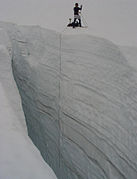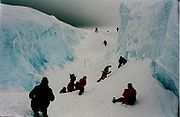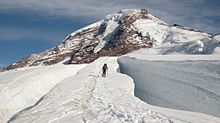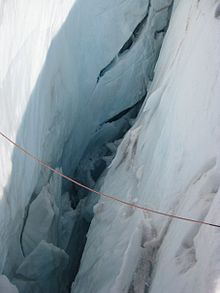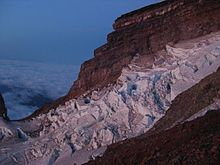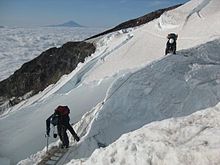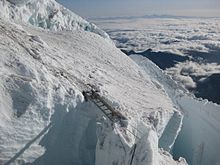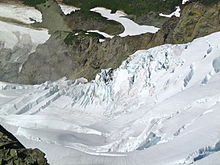- Crevasse
-
Crevasse is also a traditional term for a levee breach.
A crevasse is a deep crack in an ice sheet rhys glacier (as opposed to a crevice, which forms in rock). Crevasses form as a result of the movement and resulting stress associated with the sheer stress generated when two semi-rigid pieces above a plastic substrate have different rates of movement. The resulting intensity of the shear stress causes a breakage along the faces.
Crevasses often have vertical or near-vertical walls, which can then melt and create seracs, arches, and other ice formations. These walls sometimes expose layers that represent the glacier's stratigraphy.
Crevasses are more narrow at depth as it is here that pieces of the glacier may rub and break against each other. Crevasse size often depends upon the amount of liquid water present in the glacier. A crevasse may be as deep as 45 metres, as wide as 20 metres, and can be up to several hundred metres long.
The presence of water in a crevasse can significantly increase its penetration. Water-filled crevasses may reach the bottom of glaciers or ice sheets and provide a direct hydrologic connection between the surface, where significant summer melting occurs, and the bed of the glacier, where additional water may lubricate the bed and accelerate ice flow.
Types
Transverse crevasses are the most common crevasse type and they form in a zone of extension where the central part of the glacier is moving faster down-slope than the outer edges of the glacier, creating tensile stress. These crevasses stretch across the glacier transverse to the flow direction. They generally form where a valley becomes steeper.
Marginal crevasses extend downward from the edge of the glacier pointing upglacier. These crevasses form because of the higher speeds of the glacier near its centreline relative to its margin.
Longitudinal crevasses form parallel to flow where the glacier width s expanding. They develop in areas of compressive stress, such as where a valley widens.
A bergschrund is a crevasse that divides moving glacier ice below the bergschrund from the stagnant ice above it and may extend to bedrock below.
An Ice Pinnacle is formed when multiple crevasses intersect at the end of a glacier.
A crevasse may be covered, but not necessarily filled, by a snow bridge made of the previous year's snow. The result is that crevasses are rendered invisible and thus lethal to anyone attempting to navigate their way across a glacier. Anyone planning to travel on a glacier should be trained in crevasse rescue.
Exploring the bottom of a crevasse in AntarcticaCrevasse on the Ross Ice Shelf, January 2001See also
References
- Paterson, W.S.B., 1994, The Physics of Glaciers, 3rd edition, ISBN 0750647426.
- Boon, S., M.J. Sharp, 2003, The role of hydrologically-driven ice fracture in drainage system evolution on an Arctic glacier, Geophysical Research Letters, 30, pp. 1916.
- Das, S.B., I. Joughin, M.D. Behn, I.M. Howat, M.A. King, D. Lizarralde, M.P. Bhatia, 2008, Fracture propagation to the base of the Greenland Ice Sheet during supraglacial lake drainage, Science, 320, pp. 778.
- van der Veen, C.J., 1998, Fracture mechanics approach to penetration of surface crevasses on glaciers, Cold Regions Science and Technology, 27, pp. 31-47.
- Zwally, H.J., W. Abdalati, T. Herring, K. Larson, J. Saba, K. Steffen, 2002, Surface melt-induced acceleration of Greenland ice-sheet flow, Science, 297, pp. 218-222.
- Mountaineering: The Freedom of the Hills, 5th edition. ISBN 0-89886-309-0.
- "crevasse." Encyclopædia Britannica. 2010. Encyclopædia Britannica Online. 17 Oct. 2010.
Categories:- Geological hazards
- Glaciology
- Glacial landforms
- Alpinism
- Crevasse fields
Wikimedia Foundation. 2010.



